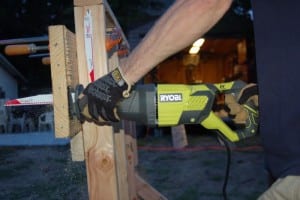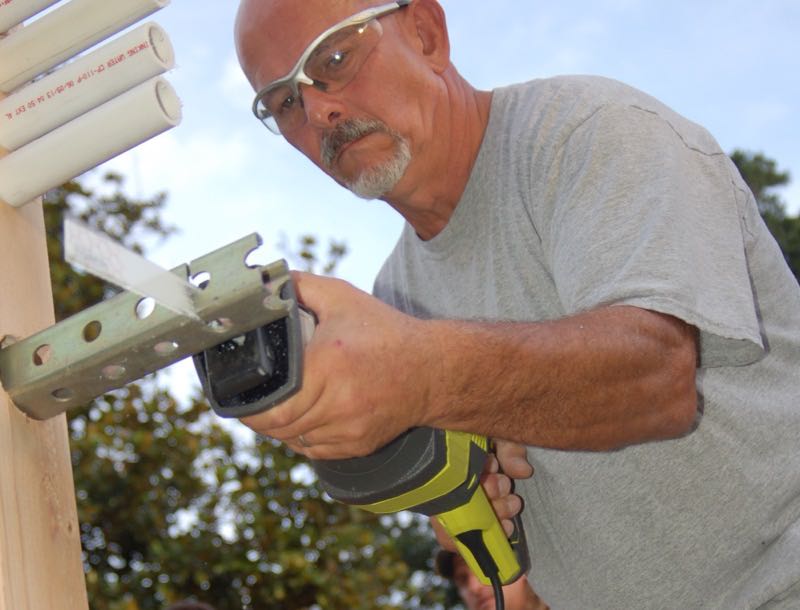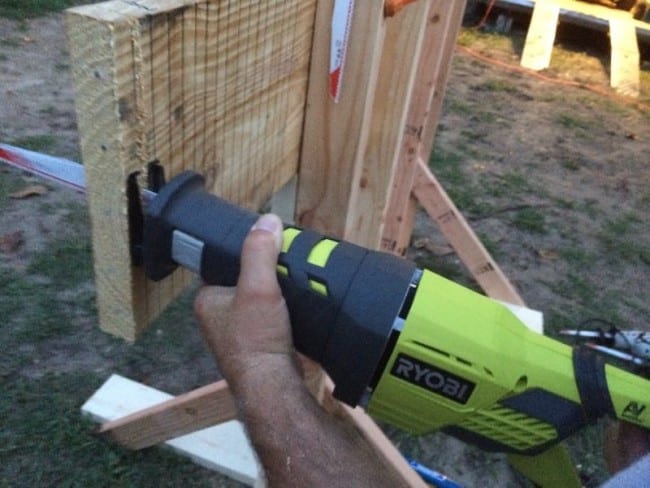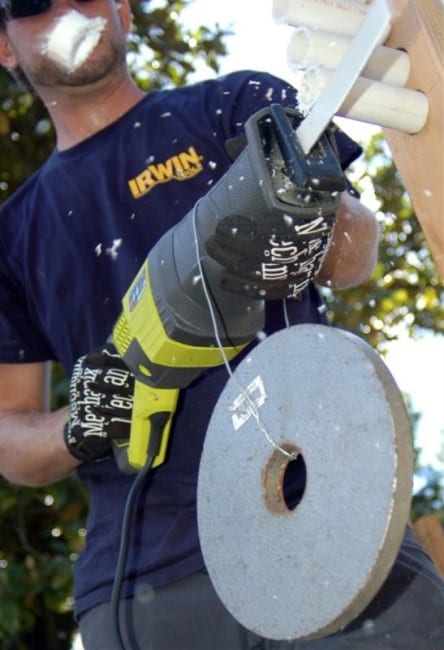There nothing more fun than taking a bunch of tools and inviting friends over to use them in a competitive match to determine the best product. That’s exactly what we did with our heavy duty reciprocating saw shootout. During the testing we discovered that Ryobi really held its own as a value leader. We were further surprised when the $65 tool actually outperformed a much higher-priced and well-recognized competitor. Taking into account the value, you could say that it bested even more brands. That’s an eye opener should you be on the lookout for a corded recip saw that will do good work and save you some money. Given it’s value and performance, taking a closer look at the Ryobi RJ186V recip saw on its own just made a lot of sense.
Ryobi RJ186V Reciprocating Saw Features
Looking at the Ryobi reciprocating saw, you have a very basic but powerful 12-amp tool (a slight upgrade to the 10-amp Ryobi RJ185V reciprocating saw) that has a variable speed switch that sends the blade from 0 to 3,000 strokes per minute in under a second. The Ryobi RJ186V reciprocating saw also has an adjustable shoe—meaning that it slides in and out in addition to pivoting to stay tight on the workpiece. Some people think this is for setting the depth of the blade, but in actuality what it does is give you more parts of the blade to use for cutting before you have to swap out the accessory. Since the Ryobi RJ186V has an aggressive 1-1/8 inch stroke, moving the shoe in or out will let you use a relatively unused portion of the blade to continue your cutting or demo work. It’s a feature that, when missing, makes us scratch our heads in amazement. About the only downside is that Ryobi makes you use a 5mm Allen wrench (not included) to move the shoe. A tool-less option, like the one included in the Ridgid Gen5X kit would have been preferable.
Blades were easy to insert and/or replace in the Ryobi RJ186V reciprocating saw. You just lift the blade release lever, insert or remove the recip saw blade (seating it all the way down), and then lowering the release lever to lock it in. Since it’s a standard blade mechanism, you can mount the blade teeth up or down—giving you more versatility when using the saw.
Ryobi RJ186V Reciprocating Saw Specs
- Power: 12 amps
- Stroke length: 1-1/8 in.
- Strokes per minute: 0-3,000 max.
- Trigger: Variable speed
- Cord length: 6 ft.
Ryobi RJ186V Reciprocating Saw Testing
We tested the Ryobi RJ186V reciprocating saw using Milwaukee Ax blades on nail-embedded wood, with PVC, and on EMT (conduit). We wanted to get a feel for how quickly it cut, and we did a lot of side-by-side testing against other competing products. We also used a lot of free-hand techniques, but our timed tests use a 5 pound weight to drive the tool through material with an equal amount of force. The Ryobi RJ186V recip saw is unique in that it’s priced under competitors by a pretty hefty margin—anywhere from $60 cheaper to over $300 less, depending upon which top model you’re looking at. Some of those heavy duty saws will cut more quickly, and with less vibration, but you’ll pay for that performance.

In nail embedded wood, the Ryobi RJ186V reciprocating saw cut through a 2×12 piece of pressure treated lumber with 5 galvanized nails in just under 13 seconds on average—a task in which it bested the DeWalt DW311 13-amp model.
With the EMT, we felt the Ryobi was more or less “in the pack”, cutting as quickly—or quicker—than DeWalt or Hitachi’s top of the line models, and nearly as fast as the Bosch RS428 14-amp reciprocating saw. Since the Ryobi RJ186V doesn’t have an orbital mode, we didn’t need to do any switching around to get it set up for this test. PVC cut like butter with this saw, and again the Ryobi RJ186V ran with the pack for the most part (with the exception of the 15-amp Milwaukee 6538-21 sawmill, which consistently cut quicker than anything else we tested).

Conclusion
It’s easy to say you want the best recip saw. The trick is understanding what that means for your business. If you’re looking to outfit a crew with the most vibration reduction possible, then you want something with a flywheel and/or decoupled handle to lower the force exerted by the blade. The Ryobi RJ186V doesn’t have that, and you can feel the difference when you hit a nail or cut through wood in particular. If you don’t do this all day, however, then you’re well within the tolerances for handling vibration, and the fact that this $65 tool keeps up with the big boys should make it very popular for crews who only need a tool to handle the occasional demo cutting task. Alternatively, if you’re a plumber who only needs to cut through the random piece of material or piping from time to time, then the savings may make a whole lot of sense—and this tool should perform well with the right blade—our tests show that. If nothing else, Ryobi has shown that its tool can take a good accessory and make it perform 80% as good as a much larger 15-amp tool. That’s impressive, and sure to get some attention the next time you’re at The Home Depot looking for a demo cutting tool.




